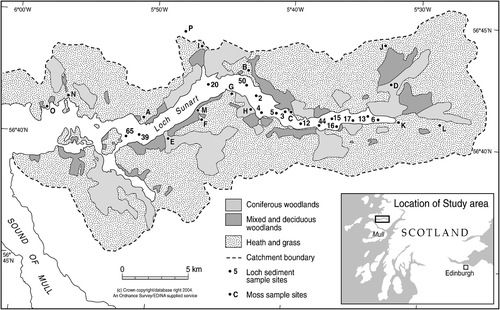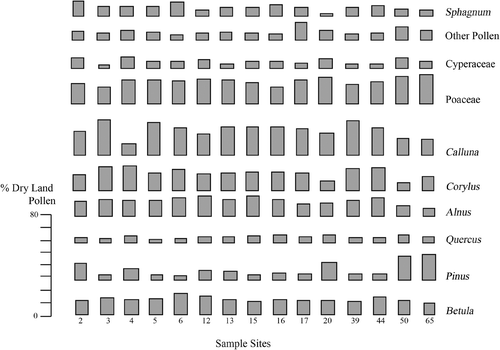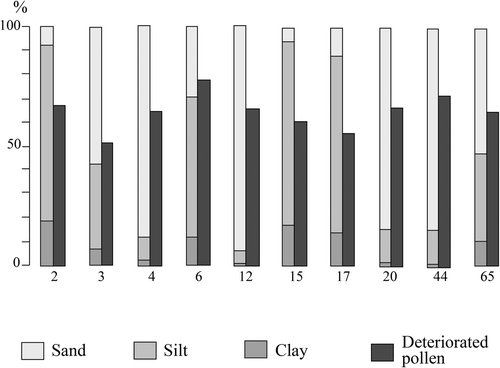Abstract
Modern pollen was extracted both from moss polster samples collected from a range of sites across the land surface of the Loch Sunart catchment, north‐west Scotland and from a number of marine sediment‐water interface sites in the sea loch. Comparisons between the pollen results and the major vegetation types growing in the catchment area revealed that in general the moss polsters contained a localised picture of the vegetation whilst the sea loch sediments varied much less from sample to sample and better represented a regional picture of the vegetation. It was anticipated that the pollen in the sea loch samples would be in a much poorer state of preservation because of the many pathways through which it travels in order to become incorporated into the sediments of the loch. However, this proved not to be the case and the study demonstrates that marine sediments of the kind found in Loch Sunart have the potential to provide a new source of Holocene vegetation data which is as good as the freshwater lake sediments that have been preferentially sampled in the past.
The difficulty of interpreting vegetation changes from pollen preserved in freshwater lake and peat deposits has led over the past forty years to increased interest in the relationships between modern pollen and the vegetation that produced it (e.g. Janssen, Citation1966; Hicks, Citation1985, Citation1997; Gaillard et al., Citation1994; Hicks & Birks, Citation1996). The main aim of this type of work has been to provide a greater understanding of these relationships so that greater confidence may be achieved in the interpretation of fossil pollen patterns. Much of the modern pollen work has concentrated either on the capture of pollen in artificial traps (e.g. Hirst, Citation1952; Tauber, Citation1974; Cundill, Citation1986; Hicks, Citation1994) or on the surface of natural materials such as mosses (e.g. Cundill, Citation1985; Gaillard et al., Citation1992) and lake surface sediments (e.g. Clayden et al., Citation1996; DeBusk, Citation1997). The efficiency of different pollen collecting materials and surfaces has been debated (e.g. Hall, Citation1989; Cundill, Citation1991; Vermoere et al., Citation2000) but there are still some natural materials that have not been comprehensively tested for their pollen collecting suitability. One such material is coastal marine sediment and although the presence of pollen has been demonstrated in marine sediments in many parts of the world (e.g. Rossignol‐Strick, Citation1995; Leroy et al., Citation2000) there have been only a few attempts to directly link modern pollen/vegetation with these sediments (e.g. Heusser et al., Citation2000). The present study attempts to do this through investigation of pollen from the sediment‐water interface in a Scottish sea loch with the aim of demonstrating the suitability of obtaining palynological records from such an environment.
The site chosen for the present study is Loch Sunart, a sea loch (fjord) located on the north‐west coast of Scotland (Figure ). The loch is approximately 31 km in length, averages 1.5 km in width, is 124 m at its deepest point and is divided into three major basins by two rock sills (Edwards & Sharples, Citation1986). The catchment area (299 km2) is predominantly high relief (>600 m), with relatively thin and poorly developed soils which rapidly translate rainfall into surface runoff. Loch Sunart exhibits typical fjordic hydrography (e.g. Elliott et al., Citation1992), with a brackish surface layer and significant (>50%) freshwater input to the loch through the upper basin catchments, notably the rivers Strontian and Carnoch. Tides are semi‐diurnal, with 4 m spring and 1 m neap tidal ranges. A small freshwater discharge: tidal ratio for Loch Sunart compared to other Scottish sea lochs (Edwards & Sharples, Citation1986) likely contributes to the frequent flushing and well mixed nature of this sea loch (Gillibrand et al., Citation1995, Citation2005).
Material and methods
Sample collection
Surface sediment samples from fifteen sites in the loch (Figure ) were collected using a Sholkovitz corer (Petersen et al., Citation1985) in order to investigate the sediment characteristics and pollen content of these modern sediments at the sediment‐water interface. In addition, moss samples were collected from sixteen Sphagnum spp. moss polsters at a range of sites in the Loch Sunart catchment (Figure ) in order to provide terrestrial modern pollen data with which the loch sediments could be compared. Considerable research has been carried out on the use of moss polsters in modern pollen work (e.g. Cundill, Citation1991; Hicks & Hyvärinen, Citation1999) and it is widely accepted that the green shoots of the moss integrate the pollen rain throughout at least one year of deposition and provides a reliable picture of the pollen rain in the immediate area around the sampling site (e.g. O'Sullivan, Citation1973; Caseldine, Citation1981; Königsson, Citation1992). The moss samples were collected by placing an inverted standard 76 mm diameter flower pot on the moss polster. The green shoots enclosed within the area of the surface of the pot were carefully marked and cut away using scissors. Both the marine and moss polster samples were stored in a cold room at 4°C until required for analysis.
Laboratory techniques
Preparation of both sets of samples for pollen counting followed standard laboratory techniques (e.g. Faegri et al., Citation1989; Moore et al., Citation1991), and a Lycopodium tablet (Stockmarr, Citation1972) was added to each sample before chemical treatment. The moss polsters were relatively simple to prepare for counting because of their organic nature. In contrast, the loch sediments were highly minerogenic and contained large quantities of quartz which involved the prolonged use of HF in order to concentrate the pollen. All pollen samples were counted at ×600 magnifications and a target pollen sum of 400 dry land pollen was achieved in the majority of samples (Table ). A few samples contained low concentrations of pollen and multiple slides had to be counted to achieve a lower pollen sum. Percentage values based on the total dry land pollen sum as well as pollen concentrations were calculated for all samples. Pollen concentrations for the loch sediment surface samples were expressed as pollen per volume of material (pollen cm3) whereas the moss polster samples were expressed as the number of pollen per surface area (pollen cm2) because no consistent volume measurement could be devised for this material. In addition, during counting the state of preservation of all pollen was recorded using four categories; undamaged, folded, split, corroded. This categorisation is similar to that first proposed by Cushing Citation(1964) although the corroded category in the present work also includes pollen described as degraded by Cushing and amorphous by Lowe Citation(1982). All dry land pollen identified during counting irrespective of its state of preservation is included in the pollen sum.
Table I. Counted dry land pollen totals used to derive the percentage values shown in the diagrams of the present study.
Results and discussion
Moss polster samples
The major plant groupings that produced the pollen in the Loch Sunart catchment were identified using a number of techniques. Map evidence, air photographs, field observations and data from Scottish Natural Heritage (SNH) archives were integrated to produce a generalised vegetation map (Figure ). The catchment contains a wide range of vegetation from open grass and heath communities to woodland of various kinds: Quercus, mixed deciduous, coniferous and mixed coniferous/deciduous. These produce a mosaic of vegetation types throughout the catchment. The moss polster relative (%) results reflect this variety of vegetation in the differences that are seen between samples (Figure ). The impact of both vegetation variety and topographical changes may be discerned in the results. For example, sample B was taken in an open area close to the oak woodland at Resipole and as a consequence has higher levels of Quercus pollen than other sites. In contrast, site D is in an open area within a pine woodland and the high Pinus pollen values reflect this local bias while site O is located in an area dominated by grass and heath which is closely mirrored in the pollen results. There are some anomalies as well, with sites I, P and J recording high tree and shrub pollen values in open, moorland environments. This suggests that strong winds are blowing pollen from the woodlands in the valley on to the exposed open watershed areas. More generally the results from the moss polsters may be grouped into two major pollen/vegetation patterns; open ground dominated by grass, sedge and heath (which reflects the open areas where these moss polsters were sampled) and woodland dominated by Pinus and Betula, along with low but persistent values of Quercus, Alnus and Corylus (which reflects the presence of the woodlands that exist near these moss polsters). Therefore, in general, the individual pollen sites are influenced by locally dominant plants and while each of the elements of a regional pattern is evident in each sample, none record the general balance between deciduous woodland, coniferous woodland and heath/grassland that is present in the catchment. This is to be expected when sampling moss polsters which have been recognised as producing a local rather than a regional picture of vegetation from their pollen results (e.g. Gaillard et al., Citation1992).
Figure 2 Relative pollen values of selected taxa from moss polsters. Values forSphagnum spores (which are not part of the dry land pollen sum) are expressed as % of total dry land pollen and as a consequence exceed 100% in samples from sites K, N and P. In order to retain the same scale throughout the diagram, the % Sphagnum values for these three sites have been shown as numbers.
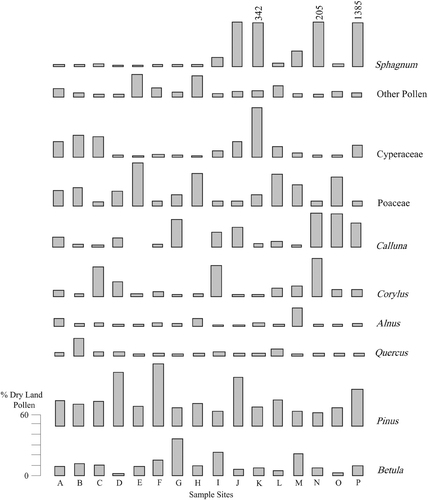
Sea loch samples
Results of pollen counts from the loch water/sediment interface samples display (Figure ) a much more consistent pattern throughout, with little variation from site to site along the length of the loch. For example, in all but one sample Betula values range between 10% and 20% of total land pollen (TLP) and Quercus demonstrates little variation, although values are all below 10% TLP. Eleven of 15 samples record Poaceae values close to 20% TLP and even the more variable record of Calluna only ranges between 10% and 30% TLP, with half the samples around 20% TLP. The values for Pinus do not exceed 20% TLP and are not high considering the proximity of pine plantations to the loch. However, pine pollen has a tendency to float on the surface of water (Faegri et al., Citation1989; Traverse & Ginsburg, Citation1966) and therefore it may have been moved by the prevailing winds to the northern and eastern edges of the loch before wetting sufficiently to sink and be incorporated into sediments. In spite of this particular problem the indications are that the pollen from the loch sediments provide a more reliable and consistent picture of the regional pollen rain in the Loch Sunart basin, a picture which does not vary significantly wherever a sample is taken in the loch. While this may appear surprising considering the multiple sources of inputs of pollen (inwashed, reworked, differentially preserved pollen and pollen transported and concentrated in particular areas) which produce a range of potential difficulties recognised by Faegri et al. Citation(1989) and Rossignol‐Strick Citation(1995), the impact of tidal flushing and mixing may ensure that a similar pollen pattern is found throughout the loch.
A Factor Analysis (Walden et al., Citation1992; Davis, Citation2002) of twenty five variables representing pollen taxa (0.5%) in all 31 sites (16 moss polsters and 15 sea loch sediments) confirms the general similarity between sea loch samples and greater disparity among moss polster samples (Figure ). These findings support the argument that sea loch sediments potentially provide an integrated record of the pollen rain for the catchment as a whole. Notable taxa that appear to be well represented and diagnostic of the sea loch samples include: Alnus, Filipendula, Succisa, Ulmus, Rosaceae and Salix. A large number of the moss polster sites are well represented by taxa which include: Ericales, Cyperaceae, Fagus, Picea and Pinus.
Figure 4 Result of Factor Analysis using twenty five variables(pollen taxa) and thirty one sites. (A) First and second factor score plot; filled circles = sea loch samples; open squares = moss polster sites. (B) First and second factor loading plot (pollen taxa). The software used in the analysis was MINITAB v14.
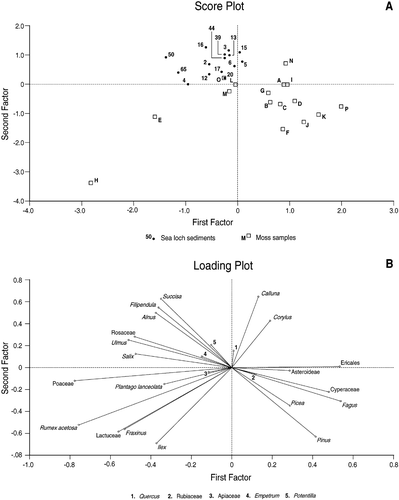
The addition of Lycopodium spores permitted the estimation of pollen concentrations although, because of the different nature of the water/sediment interface samples compared with moss polster material, the values are not directly comparable. Nevertheless the results (Figure ) demonstrate an interesting and unexpected general difference from the relative pollen results, with the moss polsters showing less variable pollen concentrations compared with the results obtained from the sea loch sediments. This is probably due to the nature of the two sets of deposits. The mosses are mostly Sphagnum spp. from the same climatic regime, have probably grown at a similar rate and have therefore captured similar numbers of pollen, varying in response to the local pollen rain rate. On the other hand the sea loch samples consist of sediments of very variable particle size and source which have accumulated at different rates in different parts of the loch.
Figure 5 Total pollen concentrations from moss polster(B) and loch sediment sites (A). Note that the moss polster concentrations are based on standard surface area collected (cm2) whereas the loch sediment concentrations are based on a standard volume of material (cm3).
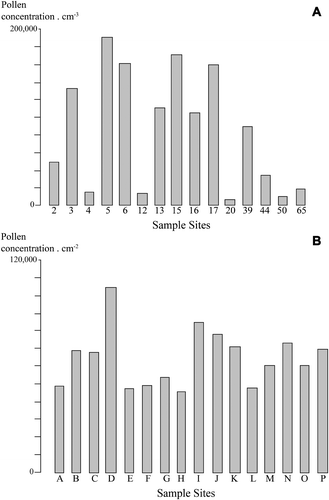
It was anticipated that, because of the complex set of variables governing the input and preservation of pollen in sea loch sediments, pollen in such environments could suffer from the effects of differential pollen preservation (i.e. mechanical and biological destruction of particular pollen taxa ‐ see Havinga, Citation1985) which may distort the resultant pollen record. However, an analysis of the state of preservation of the pollen suggests otherwise (Figure ); the results appear to show that there are no significant differences in the numbers of deteriorated pollen (folded, split and corroded) between the moss samples and the loch sediments. It was also considered that particle size might affect the preservation of pollen in sediments; the coarser the sediments, the more likely that mechanical activities (coarser sediments = more active sedimentary environments) damage pollen. This again does not seem to be the case because there appears to be no correlation between the particle size of sediments and the state of pollen preservation (Figure ). Even when the category of corroded pollen is isolated and compared with the percentage of sand in sea loch samples (Figure ) no straightforward relationship is apparent. The highest values of deteriorated pollen are found in samples with low volumes of sand. Conversely it might have been anticipated that fine grain sediments (e.g. clays) which accumulate under low energy conditions might contain higher values of undamaged pollen but Figure does not support this suggestion. The processes that cause pollen deterioration in marine sediments are clearly complex and we do not yet understand all of the factors involved.
Figure 6 Proportion of deteriorated pollen(the sum of folded, split and corroded) from moss polsters (B) and loch sediment (A) sites.
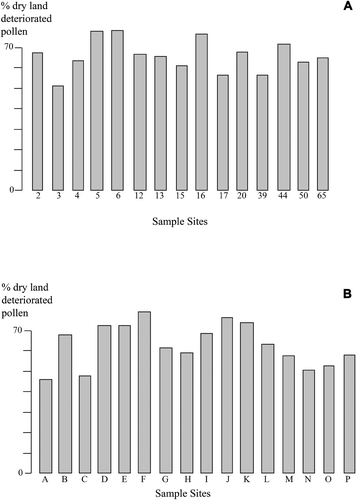
Figure 8 Graph comparing percentage corroded pollen with percentage sand and percentage undamaged pollen with percentage clay. The ten samples used for Figure provided the data for the plots illustrated here.
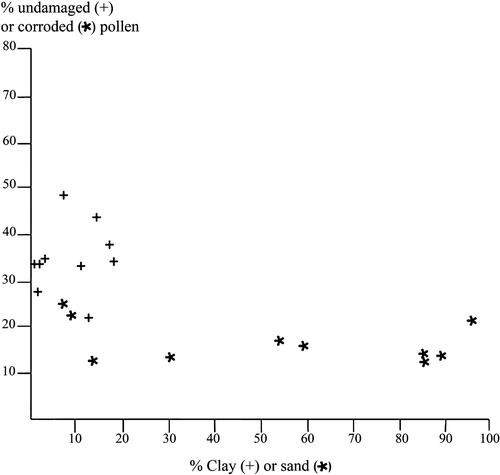
There do, however, appear to be some relationships between particle size and pollen concentrations in the loch sediments because there are indications that sites with coarser sediments (e.g. 4, 12 and 20) tend to have low pollen concentrations. However, this is not universally the case because site 3 has relatively high proportions of coarse sediment and relatively high pollen concentrations. Faegri et al. Citation(1989) state that pollen is poorly represented in marine sediments and would preferentially be preserved in sediments of similar particle size as pollen. Neither of these generalisations apply to the results from the Loch Sunart sediments, but it may be that factors such as high sediment inputs and the close proximity of the shore in a linear loch makes Loch Sunart atypical as a marine sediment site.
Conclusions
The present study has shown that good pollen preservation and high pollen concentrations can be obtained from Scottish sea loch sediments. The range of pollen taxa is basically no different from that obtained from moss polsters ( = peat bog sediments) but it does appear to reflect more consistently the regional pollen rain for the catchment compared with results obtained from mosses. The preservation of pollen extracted from sea loch sediments does not appear to be significantly affected by the complexities of pollen routeways into the sediments (although these routeways are perhaps not substantially different from those operating in large freshwater bodies) and also does not appear to be related to the particle size of the material, although it is important to recognise that coarser sediments might not provide the best environment from which to obtain high pollen concentrations, a feature common also to coarse sediments obtained from freshwater lakes and peat bogs. This means that where sea loch sediments are coarser a longer period of time counting pollen will be required to produce satisfactory pollen counts.
Overall the signs are encouraging that the sediments of the sea lochs of western Scotland will provide valuable palaeoenvironmental archives, and perhaps an intermediate location between deep sea cores and terrestrial sites, ultimately allowing a linkage to be established between the two sets of palaeoenvironmental records.
Acknowledgements
Thanks are due to Richard Bates, Alix Cage, Jack Jarvis and Fabienne Marret for assistance in the field, to Margaret Donaldson for assistance with pollen preparations, John Walden for assistance with statistical analysis and to Graeme Sandeman for drawing some of the diagrams. We are grateful to the Carnegie Trust for the universities of Scotland and the EU funded project (HOLSMEER) for financial support.
References
- Caseldine , C. J. 1981 . Surface pollen studies across Bankhead Moss, Fife, Scotland. . J. Biogeogr. , 8 : 7 – 25 .
- Clayden , S. L. , Cwynar , L. C. and MacDonald , G. M. 1996 . Stomate and pollen content of lake surface sediments from across the tree line on the Taimyr Peninsula, Siberia. . Can. J. Bot. , 74 : 1009 – 1015 .
- Cundill , P. R. 1985 . The use of mosses in modern pollen studies at Morton Lochs, Fife. . Trans. Bot. Soc. Edinburgh , 44 : 375 – 383 .
- Cundill , P. R. 1986 . A new design of pollen trap for modern pollen studies. . J. Biogeogr. , 13 : 83 – 98 .
- Cundill , P. R. 1991 . Comparisons of moss polster and pollen trap data: A pilot study. . Grana , 30 : 301 – 308 .
- Cushing , E. J. 1964 . Redeposited pollen in late Wisconsin pollen spectra from East‐Central Minnesota. . Am. J. Sci. , 262 : 1075 – 1088 .
- Davis , J. C. 2002 . Statistics and data analysis in geology , New York : J. Wiley .
- DeBusk , G. H. 1997 . The distribution of pollen in the surface sediments of Lake Malawi, Africa, and the transport of pollen in large lakes. . Rev. Palaeobot. Palynol. , 97 : 123 – 153 .
- Edwards , A. and Sharples , F. 1986 . Scottish Sea Lochs: A catalogue , Oban/Peterborough : Scott. Marine Biol. Assoc./Nat. Conserv. Counc .
- Elliott , A. J. , Gillibrand , P. A. and Turrell , W. R. 1992 . “ Tidal mixing near the sill of a Scottish sea loch. ” . In Dynamics and exchanges in estuaries and the coastal zone , Edited by: Prandle , D . 35 – 56 . Washington, DC : Am. Geophys. Union . Coast. Estuar. Stud., 40
- Faegri , K. and Iversen , J. 1989 . New York : J. Wiley & Sons . Textbook of pollen analysis (4th ed. by K. Faegri, P. E. Kaland & K. Krzywinski)
- Gaillard , M. ‐J. , Birks , H. J. B. , Emanuelsson , U. and Berglund , B. E. 1992 . Modern pollen/land‐use relationships as an aid in the reconstruction of past land‐uses and cultural landscapes: An example from south Sweden. . Veget. Hist. Archaeobot. , 1 : 3 – 17 .
- Gaillard , M. ‐J. , Birks , H. J. B. , Emanuelsson , U. , Karlsson , S. , Lagerås , P. and Olausson , D. 1994 . Application of modern pollen/land‐use relationships to the interpretation of pollen diagrams – reconstructions of land‐use history in south Sweden, 3000‐0 BP. . Rev. Palaeobot. Palynol. , 82 : 47 – 74 .
- Gillibrand , P. A. , Cage , A. G. and Austin , W. E. N. 2005 . A preliminary investigation of basin water response to climate forcing in a Scottish fjord: Evaluating the influence of the NAO. . Contrib. Shelf Res. , 25 : 571 – 587 .
- Gillibrand , P. A. , Turrell , W. R. and Elliott , A. J. 1995 . Deep‐Water renewal in the Upper Basin of Loch Sunart, a Scottish fjord. . J. Phys. Oceanogr. , 25 : 1488 – 1503 .
- Hall , V. M. 1989 . A comparison of grass foliage, moss polsters and soil surfaces as pollen traps in modern pollen studies. . Circaea , 6 : 63 – 69 .
- Havinga , A. J. 1985 . A 20‐year experimental investigation into the differential corrosion susceptibility of pollen and spores in various soil types. . Pollen Spores , 26 : 541 – 558 .
- Heusser , L. E. , Lyle , M. and Mix , A. 2000 . Vegetation and climate of the northwest coast of North America during the last 500 K.Y.: High‐resolution pollen evidence from the northern California margin. . Proc. Ocean Drill. Progr. Sci. Res. , 167 : 217 – 226 .
- Hicks , S. 1985 . Modern pollen deposition records from Kuusamo, Finland: I. Seasonal and annual variation. . Grana , 24 : 167 – 184 .
- Hicks , S. 1994 . Present and past pollen records of Lapland forests. . Rev. Palaeobot. Palynol. , 82 : 17 – 35 .
- Hicks , S. 1997 . Pollen analogues and pollen influx values as tools for interpreting the history of a settlement centre and its hinterland. . Birka Stud. , 4 : 137 – 150 .
- Hicks , S. and Birks , H. J. B. 1996 . Numerical analysis of modern and fossil pollen spectra as a tool for elucidating the nature of fine‐scale human activities in boreal areas. . Veget. Hist. Archaeobot. , 5 : 257 – 272 .
- Hicks , S. and Hyvärinen , H. 1999 . Pollen influx values measured in different sedimentary environments and their palaeoecological implications. . Grana , 38 : 228 – 242 .
- Hirst , J. M. 1952 . An automatic volumetric spore trap. . Ann. Appl. Biol. , 39 : 257 – 265 .
- Janssen , C. R. 1966 . Recent pollen spectra from the deciduous and coniferous‐deciduous forests of north‐eastern Minnesota: A study in pollen dispersal. . Ecology , 47 : 804 – 825 .
- Königsson , L. ‐K. 1992 . The recent pollen rain in some alpine and sub‐alpine environments in the southern parts of the Scandinavian mountains and its bearing on investigations of Holocene forest‐line shifts. . Acta Bot. Fenn. , 144 : 19 – 34 .
- Leroy , S. , Marret , F. , Gasse , F. and Chalie , F. 2000 . Understanding the Caspian Sea erratic fluctuations: Palynological results from the south basin. . Terra Nostra , 7 : 45 – 49 .
- Lowe , J. J. 1982 . Three Flandrian pollen profiles from the Teith Valley, Perthshire, Scotland. II. Analysis of deteriorated pollen. . N. Phytol. , 90 : 371 – 385 .
- Moore , P. D. , Webb , J. A. and Collinson , M. E. 1991 . An illustrated guide to pollen analysis , 2 , London : Hodder & Stoughton .
- O'Sullivan , P. E. 1973 . Contemporary pollen studies in a native Scots pine ecosystem. . Oikos , 24 : 143 – 150 .
- Petersen , J. F. , Malcolm , S. J. and Sholkovitz , E. R. 1985 . A lightweight gravity corer for undisturbed sampling of soft sediments. . Can. J. Earth Sci. , 22 : 133 – 135 .
- Rossignol‐Strick , M. 1995 . Sea‐land correlation of pollen records in the eastern Mediterranean for the glacial‐interglacial transition:Biostratigraphy versus radiometric time‐scale. . Quat. Sci. Rev. , 14 : 893 – 915 .
- Stockmarr , J. 1972 . Tablets with spores used in absolute pollen analysis. . Pollen Spores , 13 : 615 – 621 .
- Tauber , H. 1974 . A static non‐overload pollen collector. . N. Phytol. , 73 : 359 – 369 .
- Traverse , A. and Ginsburg , R. N. 1966 . Palynology of the surface sediments of the Great Bahamas Bank, as related to water movement and sedimentation. . Mar. Geol. , 4 : 417 – 459 .
- Vermoere , M. , Vanhecke , L. , Waelkens , M. and Smets , E. 2000 . A comparison between modern pollen spectra of moss cushions and Cundill pollen traps: Implications for the interpretation of fossil pollen data from southwest Turkey. . Grana , 39 : 146 – 158 .
- Walden , J. , Smith , J. P. and Dackombe , R. V. 1992 . The use of simultaneous R‐ and Q‐mode factor analysis as a tool for assisting interpretation of mineral magnetic data. . Mathem. Geol. , 24 : 227 – 247 .
